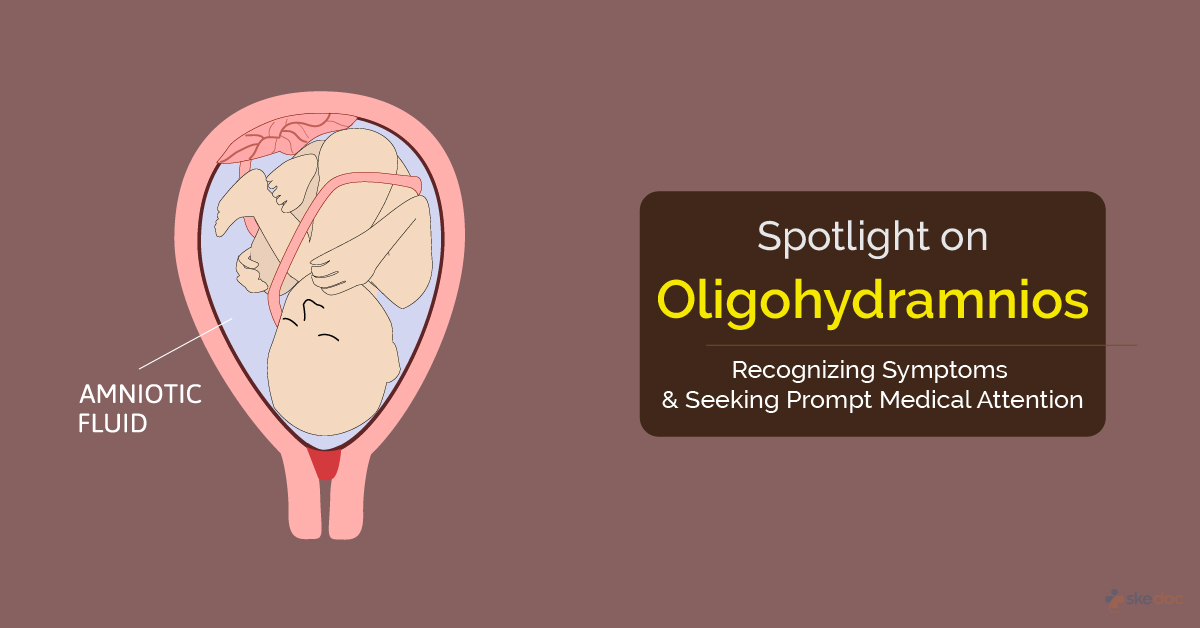Allergy
Blood Diseases
Bone & Joints
Brain
Cancer
Child Care
Cosmetic Surgery
Diabetes
Endocrinology
ENT
Eye
Gen Medicine
General Surgery
Heart
Kidney
Lifestyle
Liver & Digestive
Lung
Men’s Health
Mental health
Physiotherapy
Rheumatology
Skin and hair
Sleep Disorders
Spine
Transplant
Women Health
Thyroid
Vascular Surgery
Oligohydramnios

What is Oligohydramnios?
Oligohydramnios is a condition seen during pregnancy with less than a normal amount of amniotic fluid within the amniotic sac. The amniotic fluid functions as a cushion that protects the fetus inside the womb and helps transfer nutrients and fluids between the fetus and the mother.
Is Oligohydramnios a Medical Emergency?
Oligohydramnios is not a medical emergency, but early identification and management are essential to avoid complications.
Causes
Oligohydramnios may be caused by the following:
- Premature rupture of membranes
- Fetal urinary tract abnormalities - Amniotic fluid mainly comprises fetal urine in the second half of the pregnancy; therefore, a fetal urinary tract abnormality such as the following can cause Oligohydramnios.
- Renal agenesis
- Polycystic kidney
- Obstructive lesions of the fetal urinary tract
- Placental insufficiency - A condition where the placenta cannot supply sufficient nutrients and oxygen. It can be caused by:
- Pregnancy - Induced hypertension
- Maternal diabetes
- Post-maturity syndrome - When the pregnancy extends beyond 42 weeks
- Maternal use of certain medications such as - Prostaglandin synthase inhibitors, angiotensin-converting enzyme inhibitors, and COX inhibitors.
- Intrauterine infections during pregnancy
- Fetal chromosomal anomalies
Risk factors
Some risk factors may include:
- Maternal substance abuse
- Autoimmune diseases in the mother
- Liver disease in the mother
- Maternal diabetes
- Maternal hypertension
Signs & Symptoms
The symptoms and signs may include:
- Abnormal fundal height - The distance between the top of the uterus and the pubic bone is less than normal according to the pregnancy period.
- The position of the fetus inside the uterus is not normal - It may be presented with the bottom or shoulders first.
- The fetal parts, such as the head or limbs, may be unduly prominent and felt through the mother’s abdomen.
Investigations
The following investigations may be done for Oligohydramnios:
- Laboratory tests:
- CBP & ESR
- Complete urine examination
- Renal function tests
- Liver function tests
- Lecithin sphingomyelin ratio (L:S) - To assess fetal lung condition
- Phosphatidylglycerol concentration - To assess fetal lung condition
- Autoantibody tests - To rule out systemic lupus erythematosus(SLE)
- Tox screen - To check for maternal substance abuse
- Imaging tests:
- Ultrasound
- Serial amniotic fluid index (AFI) measurement
- Uterine artery Doppler study - To assess placental insufficiency
- Ultrasound
- Transabdominal instillation of indigo carmine - To assess premature rupture of membranes
Diagnosis
A diagnosis of Oligohydramnios is established based on medical history, clinical evaluation, and investigation results. A diagnosis of Oligohydramnios has been suspected if the amniotic fluid is less than 8 cm on ultrasound and is confirmed if it is less than 5 cm.
Other diagnostic indicators are as follows:
- Uterine size is much smaller than usual for the period of pregnancy
- There are fewer fetal movements
- The uterus is filled with the fetus because of the absence of amniotic fluid
- There is fetal malpresentation inside the uterus
- There is evidence of intrauterine growth retardation (IUGR) in the fetus
- Fetal tract abnormality is suspected when there is an absence of normal filling and emptying of the fetal bladder
Treatment options
The aim of the treatment of Oligohydramnios depends on the time of diagnosis, the severity of the condition, and the presence or absence of any fetal abnormalities.
Medical management
Medical management of Oligohydramnios may include the following:
- Rehydration - The mother's oral or intravenous rehydration is done to increase the amniotic fluid volume. Oral or iv rehydration of up to 2 litres/day may be done.
Interventional including surgery and indications for surgery
The following may be done:
- Amnioinfusion - It is done by introducing an isotonic sodium chloride solution through the cervix. (It is done at centres specializing in invasive fetal medicine).
- It is usually done during the second trimester via the abdominal route
- It may be done at the time of delivery to reduce umbilical cord compression, fetal distress, and aspiration of the meconium
- Induced or cesarian delivery - is indicated in cases of postmaturity
Role of Diet/ Exercise/ Lifestyle changes/ Preventive measures
The following measure may be effective in the management of Oligohydramnios:
- Complete rest - It is believed to help increase the amniotic fluid levels and may also help if pregnancy-induced hypertension occurs.
- Genetic Counseling may be required if fetal abnormalities are suspected or detected.
Complications
The following complications may occur in the presence of Oligohydramnios:
- Marked deformation of the fetus - Which may include,
- Flattened face, low set ears, mongoloid slant, micrognathia (undersized jaws)
- Thoracic (chest) compression and narrow chest
- Bowed legs and clubbed feet
- Lung defects - Small-sized fetal lungs
- Gastrointestinal tract defects
- Intra-uterine growth retardation of the fetus
- Cord compression
Prognosis
The prognosis of Oligohydramnios is generally good if identified early and managed well.
When to contact the doctor or hospital? / How to identify the emergency or complications?
It is advisable to seek medical attention if any of the symptoms of Oligohydramnios are noticed, especially if the enlargement of the abdomen is not by the duration of the pregnancy and the fetal movements are reduced.
Indications for hospitalization if required
Hospitalization is required to manage Oligohydramnios, especially if observed or diagnosed after 26 weeks of pregnancy.
Screening methods
Serial amniotic fluid index measurement is required until delivery if Oligohydramnios has been diagnosed.
Suggested clinical specialists/ Departments to consult for this condition
Specialists from the Department of Maternal-fetal Medicine, Gynecology & Obstetrics will attend Oligohydramnios. Additional Consultations with a Pediatric Nephrologist and Pediatric Surgeon may be required.
Was this article helpful?
YesNo




